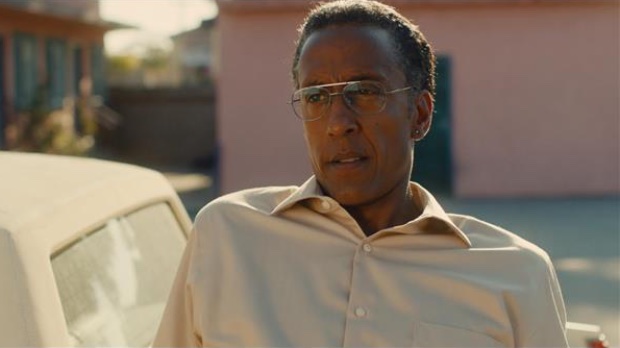 Back to selection
Back to selection
SXSW: Hunter Gatherer DP Jon Aguirresarobe on Shooting Fast, Shooting Super 16mm Dissolves and Emulating Fuji Stocks
 Hunter Gatherer
Hunter Gatherer Ashley Douglas (Andre Royo) gets out of jail eager to start over, but nothing goes as planned; his girlfriend is now his ex, he’s living with his mother, and it’s hard to find work. Josh Locy’s feature debut Hunter Gatherer (we interviewed the director here) was shot by Jon Aguirresarobe, whose attentive eye brings south Los Angeles neighborhoods to life. Prior to the film’s SXSW premiere, Aguirresarobe discussed the difficulties of production on a tight schedule, shooting dissolves on Super 16mm and attempting to emulate Fuji film stock.
Filmmaker: How and why did you wind up being the cinematographer of your film? What were the factors and attributes that led to your being hired for this job?
Aguirresarobe: I feel very fortunate to have had the opportunity to work in this film. A good friend of mine, who was later the colorist, recommended me for the job. After reading the script, I decided this was a project that I wanted to be part of and I completely trusted that instinct. I put together a series of images that represented my vision and what I believed the character of the film should be. With that in mind I sat down for an interview with the director, Josh Locy, and the conversation flowed so smoothly — we discussed the film’s visuals, how the film should look and feel. Since that moment the relationship with him has been second to none.
Filmmaker: What were your artistic goals on this film, and how did you realize them? How did you want your cinematography to enhance the film’s storytelling and treatment of its characters?
Aguirresarobe: The story, which is quite peculiar and raw, shows real characters with a very beautiful poetic undertones. For me it was essential that the visual part showed this realism and that it carried this tone throughout the film to intensify that concept — cinematography that didn’t excessively beautify the environment and that would make the audience truly believe the story we were telling. Finding the balance between realism and romanticism in the film was the biggest challenge.
Filmmaker: Were there any specific influences on your cinematography, whether they be other films, or visual art, of photography, or something else?
Aguirresarobe: We had dozens and dozens of photographs that Josh especially brought to the table. They became a great collage of inspiration for both of us.
Filmmaker: What were the biggest challenges posed by production to those goals?
Aguirresarobe: I felt very supported by the production team at all times; they never gave me “no” for an answer and they were very helpful with everything that was needed to get the film done. The biggest challenge in a film of this category is the time constraint. We shot in a short amount of time, so we needed to focus on consistency and efficiency as much as possible, but also give enough time to the director and the actors to work on their takes. The practical locations were small so the practical lighting had the most prominence when illuminating the spaces.
Filmmaker: What camera did you shoot on? Why did you choose the camera that you did? What lenses did you use?
Aguirresarobe: We shot the film with an ARRI AMIRA for the hand-held and a mix of Zeiss Super Speeds and Zeiss Master Primes. We needed the fantastic 27mm and 40mm Master Prime to complete the set of Super Speed optics in order to operate the angular lens indoors without getting too much distortion.
We also shot poetic elements as transitions in Super 16mm, Kodak 5219. These transitions are shots made with double exposure in camera and done practically. For this we had the collaboration of cinematographer Delaney Teichler, who did a tremendous job.
Filmmaker: Describe your approach to lighting.
Aguirresarobe: The approach of the light was based in real life and in the character of the spaces in which we shot. Sometimes these spaces were re-worked and molded by light to favor the intention of the sequence but always respecting the natural character and direction of the light. In my opinion this film did not require glossy or over-stylized lighting.
Filmmaker: What was the most difficult scene to realize and why? And how did you do it?
Aguirresarobe: The most difficult one was the one we shot inside a hotel room with our two lead actors. The room was full of refrigerators and the space was very limited. The actors had long dialogues and had to move through the space and between the refrigerators, it was very challenging. We used LED lights hidden throughout and the gaffer, Josh Atkin, had to dim them depending on the position of the camera and the actors at the moment. It was a bit of an orchestration.
Filmmaker: Finally, describe the finishing of the film. How much of your look was “baked in” versus realized in the DI?
Aguirresarobe: The DI was made by Alex Bickel of ColorCollective in NYC and with his process we were able to take the film to the next level. We did not change the look nor the intention of what was originally shot but we were able to give it a dirtier tone and intensify that look that we were looking for. For the process we used a pre-customized color LUTs to emulate Fuji film stock to give the film a more vintage and nostalgic look.
Camera: ARRI AMIRA / ARRI SR3
Lenses: Zeiss Super Speed / Zeiss Master Primes
Lighting: Small HMI package, KINOs and Litepanels and Litegear LEDs
Processing: Digital/super 16mm
Color Grading: Colorcollective NY, Resolve
